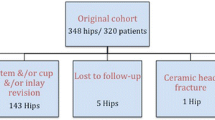Abstract
Purpose
It is unclear whether late THA periprosthetic femoral fractures are related to a mechanical mechanism that decreases strength of the femur (for example, loosening) or to a biological problem as osteolysis. It is also unknown if ceramic on ceramic bearing couples decrease the risk of late periprosthetic fractures as a result of the absence of wear and osteolysis.
Material and methods
We therefore asked whether the cumulative long-term fractures were different according to the couple of friction ceramic on ceramic or ceramic on polyethylene in 327 patients (654 hips) with bilateral THA (one ceramic-ceramic, and the contralateral ceramic-polyethylene) who had THA with cemented stems performed between from 1978 to 2000 for osteonecrosis.
Results
There were two intra-operative fractures (0.3%). The median follow-up was 22 years (range, 15–40 years), and at the most recent follow-up, the cumulative number of late (after 7 years of follow-up) post-operative fractures was 32 (5% of 654 hips). Fractures were unilateral, which means for the 327 patients, a 10% rate of fractures. Periprosthetic fractures increased in number with follow-up: seven fractures (1% of 654 hips) occurred within ten years of THA implantation, 20 (3%) within 20 years, 26 (4%) within 30 years, and 32 (5%) within 40 years. The risk of fracture was influenced (p < 0.001) by the bearing surfaces at the time of prosthetic implantation, low (0.3%) for ceramic on ceramic (1/32 fractures; 1/327 hips), high (10%) for ceramic on PE (31/32 fractures; 31/327 hips).
Conclusion
In summary, when the contralateral hip of the same patient is the control, after 40 years of follow-up, post-operative fractures occur 30 times more often on the side with PE cup than on the side with ceramic/ceramic bearing.



Similar content being viewed by others
References
Abdel MP, Watts CD, Houdek MT, Lewallen DG, Berry DJ (2016) Epidemiology of periprosthetic fracture of the femur in 32 644 primary total hip arthroplasties: a 40-year experience. Bone Joint J 98–B:461–467
Berry DJ (2003) Periprosthetic fractures associated with osteolysis: a problem on the rise. J Arthroplast 18:107–111
Hernigou P, Zilber S, Filippini P, Poignard A (2009) Ceramic-ceramic bearing decreases osteolysis: a 20-year study versus ceramic polyethylene on the contralateral hip. Clin Orthop Relat Res 467:2274–2280
Sidler-Maier CC, Waddell JP (2015) Incidence and predisposing factors of periprosthetic proximal femoral fractures: a literature review. Int Orthop Sep 39(9):1673–1682
Arabmotlagh M, Sabljic R, Rittmeister M (2006) Changes of the biochemical markers of bone turnover and periprosthetic bone remodeling after cemented hip arthroplasty. J Arthroplast 21:129
Lindahl H, Malchau H, Herberts P, Garellick G (2005) Periprosthetic femoral fractures classification and demographics of 1049 periprosthetic femoral fractures from the Swedish National Hip Arthroplasty Register. J Arthroplast 20:857–865
Cook RE, Jenkins PJ, Walmsley PJ, Patton JT, Robinson CM (2008) Risk factors for periprosthetic fractures of the hip: a survivorship analysis. Clin Orthop Relat Res 466:1652–1656
Ricioli W Jr, Queiroz MC, Guimarães RP, Honda EK, Polesello G, Fucs PM (2015) Prevalence and risk factors for intra-operative periprosthetic fractures in one thousand eight hundred and seventy two patients undergoing total hip arthroplasty: a cross-sectional study. Int Orthop. Oct 39(10):1939–1943
Lindahl H (2007) Epidemiology of periprosthetic femur fracture around a total hip arthroplasty. Injury 38:651–654
Frenzel S, Vécsei V, Negrin L (2015) Periprosthetic femoral fractures—incidence, classification problems and the proposal of a modified classification scheme. Int Orthop. Oct 39(10):1909–1920
Abdel MP, Cottino U, Mabry TM (2015) Management of periprosthetic femoral fractures following total hip arthroplasty: a review. Int Orthop. Oct 39(10):2005–2010
Amenabar T, Rahman WA, Avhad VV, Vera R, Gross AE, Kuzyk PR (2015) Vancouver type B2 and B3 periprosthetic fractures treated with revision total hip arthroplasty. Int Orthop. Oct 39(10):1927–1932
Lindahl H, Oden A, Garellick G, Malchau H (2007) The excess mortality due to periprosthetic femur fracture. A study from the Swedish national hip arthroplasty register. Bone 40:1294–1298
Jakubowitz E, Seeger JB (2015) Periprosthetic fractures: concepts of biomechanical in vitro investigations. Int Orthop Oct 39(10):1971–1979
Author information
Authors and Affiliations
Corresponding author
Ethics declarations
Conflict of interest
The authors declare that they have no conflict of interest.
Ethical approval
All procedures were in accordance with the ethical standards of the institutional and/or national research committee and with the 1964 Helsinki declaration and its later amendments or comparable ethical standards.
Informed consent
Informed consent was obtained from all individual participants included in the study.
Rights and permissions
About this article
Cite this article
Hernigou, P., Auregan, J.C., Bastard, C. et al. Higher prevalence of periprosthetic fractures with ceramic on polyethylene hip bearing compared with ceramic on ceramic on the contralateral side: a forty year experience with hip osteonecrosis. International Orthopaedics (SICOT) 42, 1457–1461 (2018). https://doi.org/10.1007/s00264-018-3863-5
Received:
Accepted:
Published:
Issue Date:
DOI: https://doi.org/10.1007/s00264-018-3863-5




